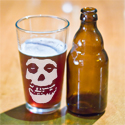|
Xiuhteuctli posted:Ah drat. I pitched at about 66 degrees, and I've seen very little activity since then. I hope it doesn't stall at 7% Don't worry about not seeing activity. I recently had a couple beers stall out (they got down to mid-50s during a cold snap) at somewhere around 1.030 myself. I got the fermentation restarted by bringing them to a warmer place, and they eventually finished down near 1.012 where they were supposed to, but I didn't see much visible activity after I restarted them even though the first part of the fermentation (from around 1.060 to 1.030) was very violent. Just keep it warm and check on it in a few days or a week.
|
|
|
|

|
| # ? Apr 28, 2024 06:06 |
|
Imaduck posted:If those measurements are correct, then traditional calculations would say you're somewhere close to 14% ABV (see, e.g., http://www.brewersfriend.com/abv-calculator/). Ending up at 1.006 is quite a good finish, and about as low as you can expect to go. The alternate equation on the calculator is supposed to be more accurate for high starting gravities and puts it at 15.24% vs 13.78%. Regardless, a drop of 100 points is expected for meads according to Schramm. 1.006 is probably going be right between dry and semi-sweet. I've seen EC-1118 chew threw everything and end up below 1.000. Who Dat posted:Being a complete newbie, I'm unsure of how to read it. I tasted a bit and other that being a bit zingy and dry, it tastes pretty strong. Give it a few months to settle out, sample it again and rack it. After another few months it should be clear enough to rack into a bottling bucket and bottle. If not, rack again and wait a few months. What kind of honey did you end up using?
|
|
|
|
Imaduck posted:Anyone have recommendations for actual kegerator build instructions? Specifically, I'm working with a chest freezer and will likely use a tower. I'm currently building a keezer, we chose to go with a collar instead of a tower because of the ease of construction and because the extra height will give us room for another 5 gallon keg. (We looked into the price of 2.5 or a 3 gallon kegs and holy christ those are expensive!) Sure it doesn't look quite as cool and you have to build the collar, but constructing a rectangle isn't that hard. Its definitely a lot easier than figuring out how to keep the exposed lines cool and either building casters or placing the keezer in the middle of our tiny apartment so we can open the lid.
|
|
|
|
Whodat Smith-Jones posted:Well, Beersmith put me at 24.4 SRM with that grain bill I listed above, and the picture seems to be about as dark as I'd like. I double checked Beersmith's preloaded color profiles with what I could find on Google and they all appear to be accurate, so it's not like I'd be getting projected results that would actually be way off. Dropping the chocolate malt down to 2 oz just makes it look like it'll turn out way too light. 4 oz would be on the lower end of the color spectrum for the style by the looks of things, but if you're saying even that would be too much then what other options would I have? OK, then you should be OK. That's darker than I picture brown ales, but if the color is how you want it, then no worries at all. One 24SRM beer I made was a pretty deep black-coffee color. As to the flavor, I don't think it will be too roasty.
|
|
|
|
Cpt.Wacky posted:The alternate equation on the calculator is supposed to be more accurate for high starting gravities and puts it at 15.24% vs 13.78%. Regardless, a drop of 100 points is expected for meads according to Schramm. 1.006 is probably going be right between dry and semi-sweet. I've seen EC-1118 chew threw everything and end up below 1.000. CPR wacky is right. Let that mead age out and clear. That really alcoholy taste with smooth out with time, and you'll think your drinking a nice 8% when you're really drinking something much higher.
|
|
|
|
Jo3sh posted:OK, then you should be OK. That's darker than I picture brown ales, but if the color is how you want it, then no worries at all. One 24SRM beer I made was a pretty deep black-coffee color. Hmmm. I think I might switch from UK chocolate malt to US chocolate malt since that's apparently a bit lighter then if your 24 SRM beer was that dark. Good to hear it shouldn't be too roasty. Thanks!
|
|
|
|
Anyone have any thoughts on this recipe? It is an attempt at a Zombie Dust clone that I found on one of the forums. Only change that I made was to add the chocolate to darken it just a tad, plus I had to back off the hops a bit because the Citra I just ordered had a little higher AA. Big question I have is on the fermentation temp: I've never used that yeast before so I'm not really sure where to go with it. It seems like people like to let it go a little bit cooler than the stuff I usually use on PAs (ie WLP001) but I wasn't totally sure about that. Brew Method: All Grain Style Name: American Pale Ale Boil Time: 60 min Batch Size: 4.5 gallons (fermentor volume) Boil Size: 6 gallons Efficiency: 65% (brew house) STATS: Original Gravity: 1.059 Final Gravity: 1.016 ABV (standard): 5.55% IBU (tinseth): 44.52 SRM (morey): 12.27 FERMENTABLES: 9.5 lb - American - Pale 2-Row (85.4%) 6 oz - American - Caramel / Crystal 60L (3.4%) 6 oz - American - Carapils (Dextrine Malt) (3.4%) 6 oz - American - Munich - Light 10L (3.4%) 6 oz - German - Melanoidin (3.4%) 2 oz - American - Chocolate (1.1%) HOPS: 0.5 oz - Citra for 45 min, Type: Pellet, Use: Boil (AA 13.8, IBU: 28.22) 0.5 oz - Citra for 10 min, Type: Pellet, Use: Boil (AA 13.8, IBU: 11.15) 0.5 oz - Citra for 3 min, Type: Pellet, Use: Boil (AA 13.8, IBU: 3.82) 0.5 oz - Citra for 1 min, Type: Pellet, Use: Boil (AA 13.8, IBU: 1.33) 2 oz - Citra for 14 days, Type: Pellet, Use: Dry Hop (AA 13.8) YEAST: Fermentis / Safale - Safale - English Ale Yeast S-04 Starter: Yes NOTES: 2L starter Ferment at 62 until complete. Secondary, dry hop 14 days
|
|
|
|
For the sake of  Tasted it today (less than a week later) and it's getting very sour ... so looks like that was a success. Going to strain it and add to the fermenter on BW brewday next week 
|
|
|
|
14 days of dry hopping is far too long from everything I've read. You're going to get a lot of vegetive aromas from the hops, not the tropical aromas. This article suggests, through a small study, that dry hopping for one day is ideal for aroma. The Mad Fermentationist also has a great article on hop usage in general. Mr. Malty also has a great article that has swayed me from ever using hops before 15 minutes in a hop forward beer. What I plan to do with my Citra pale ale is to throw 3 ounces from 15 minutes to flame-out. I then plan to ferment it out then cold crash for 3 days. I then plan to rack to secondary on-top of a sanitized/closed cheesecloth bag containing 1-3 ounces of Citra for one day. I am going to rack onto the hops to grab as much hop oils as I can. After a day it's back to cold crashing and hop removal for bottling. It may be excessive, but these guys know more than I and it's worth a shot. Edit: Why are you using chocolate malt? I personally would only use a pale malt with 5%-10% crystal 40. At least that's similar to what is in Brewing Classic Styles. Midorka fucked around with this message at 03:45 on Feb 13, 2013 |
|
|
|
What's the consensus on some sort of hop rest after flame out?
|
|
|
|
Midorka posted:14 days of dry hopping is far too long from everything I've read. You're going to get a lot of vegetive aromas from the hops, not the tropical aromas. I was going off of this article and handful of other threads that suggest around two weeks. In the past I've just thrown hops in the keg and left them there until it floated. I've never gotten any off flavors I could taste. To be honest I had no idea the length of time was a concern. quote:Edit: Why are you using chocolate malt? I personally would only use a pale malt with 5%-10% crystal 40. At least that's similar to what is in Brewing Classic Styles. Just to darken the color a tad. I didn't think such a small amount would affect the flavor any, am I wrong in that assumption?
|
|
|
|
I have a pear cider I'm brewing from a tinned cider kit sitting in my fermenter at the moment that I would like to turn into a blueberry & pear cider. I'm thinking that after about a week or so i'm going to put some frozen blueberries into a muslin bag and throw them in the fermenter. Is this likely to have the desired effect? Will a pound of the berries give much flavour to 20L of cider?
|
|
|
|
Midorka posted:14 days of dry hopping is far too long from everything I've read. You're going to get a lot of vegetive aromas from the hops, not the tropical aromas. This article suggests, through a small study, that dry hopping for one day is ideal for aroma. The Mad Fermentationist also has a great article on hop usage in general. Mr. Malty also has a great article that has swayed me from ever using hops before 15 minutes in a hop forward beer. I'm pretty sure I just read a mad fermentationist article today where he talks about experiencing no ill effects from dry hopping for an extended period of time. He hypothesizes that the vegetal flavors come from chlorophyll, which is going to be more prevalent in a pelleted hop. In any case, I think that dry hopping for only one day is a huge waste of money, but I've never done that before. I've always dry hopped for 7-14 days and have never noticed any grassy flavors. I also always use whole hops, although I'm not convinced that makes a difference. That first article you linked is pretty interesting but I'm going to take it with a grain of salt for now. Maybe next time I brew I'll do a side by side with a long and a short dry hop schedule and see for myself. Anyway, let us know how the one day dry hop goes for you. Mikey Purp fucked around with this message at 04:10 on Feb 13, 2013 |
|
|
|
bewbies posted:I was going off of this article and handful of other threads that suggest around two weeks. In the past I've just thrown hops in the keg and left them there until it floated. I've never gotten any off flavors I could taste. To be honest I had no idea the length of time was a concern. 2 oz. of Chocolate Malt is likely to get you to some kind of Amber ale depending on the source of your malt. Not entirely sure why you would want a ZD clone to be particularly dark. As for dry hopping, 14 days shouldn't be a huge deal - Pliny the Elder has a 14 day dry hop without removing any of the hops at all the entire time. I just did Kern River Citra with a 12 day dry hop and I didn't notice any of these vegetal flavors either and the dry hop was ridiculous, like 4 oz. total or even more, I forget. If you're actually going for ZD (a beer I've never had), its listed as 60 IBU on TF's site, so I'd either up your bittering addition or all of your late additions. Angry Grimace fucked around with this message at 04:36 on Feb 13, 2013 |
|
|
|
Whodat Smith-Jones posted:Hmmm. I think I might switch from UK chocolate malt to US chocolate malt since that's apparently a bit lighter then if your 24 SRM beer was that dark. Good to hear it shouldn't be too roasty. Thanks! Or if your brew shop has it, look for the Fawcett pale chocolate. It has both a milder roasty flavor and a paler color. I like it a lot.
|
|
|
|
Scythe posted:Don't worry about not seeing activity. I recently had a couple beers stall out (they got down to mid-50s during a cold snap) at somewhere around 1.030 myself. I got the fermentation restarted by bringing them to a warmer place, and they eventually finished down near 1.012 where they were supposed to, but I didn't see much visible activity after I restarted them even though the first part of the fermentation (from around 1.060 to 1.030) was very violent. Just keep it warm and check on it in a few days or a week. I just checked the hydrometer readings today, and it's up to 1.025. Accounting for the changes in heat, that means I went from 1.030 (Saturday) to ~1.027. Weird thing: I was using a Brewer's Best kit...and they had me use a lager yeast. Seemed weird to me then.
|
|
|
|
Whodat Smith-Jones posted:Hmmm. I think I might switch from UK chocolate malt to US chocolate malt since that's apparently a bit lighter then if your 24 SRM beer was that dark. Good to hear it shouldn't be too roasty. Thanks! Sorry for the minor rant but I hate UK chocolate malt. I used it in a stout and it had this awful smell I could only describe as "swamp" and I figured I just hosed up somewhere. Then at a homebrew club meeting I sampled a stout from a guy who has won multiple gold medals and gotten to brew several pro-am beers with local breweries. It had the exact same swamp rear end character... I grilled him on the recipe and the only common factor was the UK chocolate malt we used. I'm sure it's a matter of personal taste, clearly millions of people like British beers brewed with British malts. Just pointing out that the differences run deeper than just color. I never really got how much two malts with the same name from different maltsters could vary in flavor and aroma before that experience. WaterIsPoison posted:What's the consensus on some sort of hop rest after flame out? Could you elaborate on what you want to know? One of the most interesting takeaways from the Brewing Network's "Can You Brew It?" clone series for me has been that most commercial brews have a "hop rest" as you call it, what they generally call "whirlpool hops". Just due to the nature of commercial systems, it takes a long rear end time to cool 30-300 barrels of wort. Those hops are sitting at near-boiling temperatures for up to an hour after flameout. Pro brewers adjust their recipes by reducing the early bittering additions to account for the bitterness they'll get from their late hops sitting hot for 45 minutes after the boil ends. You still get a lot of flavor and aroma because it's not at a rolling boil kicking all that hop character out, but you have to factor in the extra bitterness. I wouldn't say you need or even want to do a "hop rest" in most cases. More that if your local brewpub gives you a recipe to clone, you'll want to let the wort sit hot for like half an hour after flameout before you start chilling to get the same results.
|
|
|
|
bewbies posted:I was going off of this article and handful of other threads that suggest around two weeks. In the past I've just thrown hops in the keg and left them there until it floated. I've never gotten any off flavors I could taste. To be honest I had no idea the length of time was a concern. I'm going to bookmark that article to read myself. I'm still relatively new to brewing, but figured I'd pass on some information I've read from people that are more experienced than me. I'll try the one day dry-hop and see how it goes and report back. The information seems backed up to some degree, a small sensory panel of sorts at least. The thing about brewing though is that there is no right or wrong, just how others like to interpret it! I know it's a small panel, but the majority preferring the 1 day hop is enough for me to try it. As for the color, one thing to me is that a pale ale should be amber colored at most. I've not brewed a pale ale yet, various other beers (smoked porter, oatmeal milk stout, Belgian Brown, and a few others) so I'm not sure how much, if any, the chocolate malt will contribute, but I'm guessing it needlessly complicates the malt bill of something that's generally pretty simple. From the research I've done though you could up the crystal to 5%-8% to get some added color without complicating the grain bill, but I'd like to see how yours comes out. You're going to get a lot of conflicting information and really the best way to go is to experiment on your own! One thing that seems to be a general consensus though is that late hopping is a great way to get huge flavor and aroma without huge bitterness. I would consider putting a bit more later, but again I haven't experimented too much to have my own opinion, just going by what I've read. I will say that Firestone Walker's Double Jack is about the perfect IIPA to me and that is all, I believe, in the last 15 minutes. Edit: Also, is there any reason you're going English Ale? I've not used that, but English yeast strains can be a bit expressive. I'm going to be using American Ale for my pale ale to let the hops shine. @mikey purp: If you decide to split a batch and see how the dry hopping schedules go I think it'd be cool. @angry grimace: The only thing about Pliny and Kern's beer is that they are bigger grain bills, I would imagine they would cover up some of the flavors a bit. Also reason the Mad Fermentationist link I wonder if they filter off of the yeast first or not. Do you know? From the link I read the yeast can eat up some of the oils so that might be something to consider. Cheers all! Midorka fucked around with this message at 05:32 on Feb 13, 2013 |
|
|
|
Today, after at least two years of use with no issues, the spigot on my bottling bucket started leaking like crazy. I found out not when sanitizing it, but after the beer had already been racked into it on top of the priming sugar. I might normally be super-paranoid about my beer getting infected, if I hadn't done this once before: A few years ago, the bottle wand clip somehow managed to fall into a batch of finished beer primed for bottling, and I scrambled to get the clip out in the same way. And the beer never had any infection issues, despite being a 2.8% ABV table beer. Honestly, I think it's harder to infect beer than most people think, as long as you have good, consistent sanitation procedures and are aware of everything that's touching your beer from start to finish. What's the best Stupid Brewer Trick you guys have pulled off to save a batch or complete a process? As for the dry-hopping discussion, I would say the ideal is likely five to ten days. Based on professional and homebrewing experience, less than that is too short to get the character you want, and over two weeks risks getting negative characteristics. I will say that I've gone slightly over two weeks with no real problems, but it's not ideal. bewbies, I honestly think you can make your Zombie Dust recipe nothing but 2-row and still make it a good beer. That much crystal malt might make the beer too sweet and muddle up the hop character, that little Munich malt won't be at all detectable, and the chocolate malt simply doesn't belong there. Maybe make your malt bill half 2-row and half Munich if you want that extra bit of maltiness in there, but you're far better off going with a higher mash temperature to get extra body in a pale ale than putting in lots of different specialty malts. In general, simpler is better in any malt bill.
|
|
|
|
Cpt.Wacky posted:The alternate equation on the calculator is supposed to be more accurate for high starting gravities and puts it at 15.24% vs 13.78%. Regardless, a drop of 100 points is expected for meads according to Schramm. 1.006 is probably going be right between dry and semi-sweet. I've seen EC-1118 chew threw everything and end up below 1.000. Ah, so right on target really. I used orange blossom. Second question...transferring to the glass carboy seemed to restart a pretty decent fermentation. I used a siphon and hose and was as gentle as possible. Didn't seem to matter. Will this make it stronger? Or just make it take longer to clear before I can bottle? Marshmallow Blue posted:CPR wacky is right. Let that mead age out and clear. That really alcoholy taste with smooth out with time, and you'll think your drinking a nice 8% when you're really drinking something much higher. Good to know. It did taste like it had a bite, much like a hard liquor. I have a few small 4oz bottles I will fill when I bottle so I can try it at 2, 4, and 6 month intervals. Can't wait to see how it turns out in the end. On the other hand, how will I know if I didn't sanitize properly and some "other" bacteria go into it. Will it taste really funky? More of a general question...I think my first batch went pretty smoothly. Who Dat fucked around with this message at 05:59 on Feb 13, 2013 |
|
|
|
Rozzbot posted:I have a pear cider I'm brewing from a tinned cider kit sitting in my fermenter at the moment that I would like to turn into a blueberry & pear cider. No, a pound of berries will not give you much of anything in 20L of cider besides a bit of colour. You need to use a *lot* of blueberries to get any appreciable flavour as they're (for the purposes of brewing) one of the weaker flavoured fruits. For reference, Cantillon uses 200g/L of fruit (about 1.6 lbs per gallon) in their fruit lambics and you do get a decent but not overwhelming fruit character. If you used half that, you're looking at around 4-5 pounds of blueberries.
|
|
|
|
Ubik posted:
The recipe bewbies posted is very similar to the one I used when I tried to clone ZD (recipe courtesey of some homebrewtalk thread): code:
|
|
|
|
Who Dat posted:Second question...transferring to the glass carboy seemed to restart a pretty decent fermentation. I used a siphon and hose and was as gentle as possible. Didn't seem to matter. Will this make it stronger? Or just make it take longer to clear before I can bottle? It's possible that you're just seeing CO2 coming of solution after the transfer but it's also common for fermentation to restart after racking. If it is fermenting then it probably won't make it noticeably strong than it already is, but dropping a few points could be noticeable in the dryness. If you're really concerned then you can add some potassium metabisulfite to stop the fermentation. It's also good protection at this point against oxidation and infection. Infection of mead is likely to taste similar to infection in beers. MoreBeer has a nice chart of off-tastes/flavors somewhere on their site. Funk and sour are probably the most likely off-tastes from infection, though funk can also come from exposure to UV light, even indirect sunlight or fluorescents. Wet cardboard/stale is more likely oxidation. crazyfish posted:No, a pound of berries will not give you much of anything in 20L of cider besides a bit of colour. You need to use a *lot* of blueberries to get any appreciable flavour as they're (for the purposes of brewing) one of the weaker flavoured fruits. For reference, Cantillon uses 200g/L of fruit (about 1.6 lbs per gallon) in their fruit lambics and you do get a decent but not overwhelming fruit character. If you used half that, you're looking at around 4-5 pounds of blueberries. Assuming I did the math right 1 pound in 20 liters is about 23 g/L, so yeah it's not going to do much at all. Ken Schramm has a chart in The Compleat Meadmaker that lists recommend amounts of different fruits for mild, medium and strong fruit flavor in meads, but it should apply to other stuff too. He puts mild at 120-168 g/L (5-7 lbs) for blueberries. Medium is 7-10 lbs and strong 11+.
|
|
|
|
Docjowles posted:Sorry for the minor rant but I hate UK chocolate malt. I used it in a stout and it had this awful smell I could only describe as "swamp" and I figured I just hosed up somewhere. Then at a homebrew club meeting I sampled a stout from a guy who has won multiple gold medals and gotten to brew several pro-am beers with local breweries. It had the exact same swamp rear end character... I grilled him on the recipe and the only common factor was the UK chocolate malt we used. I'm sure it's a matter of personal taste, clearly millions of people like British beers brewed with British malts. Just pointing out that the differences run deeper than just color. I never really got how much two malts with the same name from different maltsters could vary in flavor and aroma before that experience. I usually hear it called a "hop stand" by most people I've talked to (in which you just let the wort sit around after flameout for up to 90 minutes), but the point to me is that it demonstrates that homebrew and professional recipes don't necessarily translate directly to each other. The fact that homebrewers can cool 100% of their wort in 15 minutes isn't a handicap, its just something you have to take into account when you make beers that have a lot of late hops in them. A lot of people have been experimenting with hop stands in the 180º range and such to see if it more closely translates to pro-recipes and/or gives a better/different hop flavor (the idea being that isomerization of alpha acids is low or non-existent at these lower temps) I personally have been experimenting with hop-bursting (i.e. late hopping) and find it provides enough of that hoppy character for me, but the big downside is that you need four times as much hops. Now, its not a linear function where it has to be four times better to be worth four times the hops, but its a consideration. Angry Grimace fucked around with this message at 08:40 on Feb 13, 2013 |
|
|
|
Angry Grimace posted:The actual amount of difference between maltsters is pretty often overlooked; for example, UK chocolate malt and US chocolate malt have totally different roast levels even though they're named the same - US Chocolate malt is usually a 350ºL malt and UK chocolate malt is almost always 425ºL. Another fact a lot of people aren't aware of is that almost every US specialty malt (usually Briess) like Vienna, most Crystal, Munich and Victory malts are all made from six-row, while many British crystals (e.g. Dark, Medium, Extra Dark) and Continental specialty malts are two-row derived. Then again, I'm not entirely sure that the average homebrewer could tell the difference between straight up six-row and two-row. I've never bothered to spend the time on a batch to use six-row because everyone says it sucks. There are some situations where six-row malt is useful, though. If you have a beer that has a large amount of adjuncts, the extra enzymes in 6-row can help with conversion. I've seen partial mash Spotted Cow recipes that called for 6-row to be steeped with a ton of flaked corn and flaked barley.
|
|
|
|
crazyfish posted:There are some situations where six-row malt is useful, though. If you have a beer that has a large amount of adjuncts, the extra enzymes in 6-row can help with conversion. I've seen partial mash Spotted Cow recipes that called for 6-row to be steeped with a ton of flaked corn and flaked barley.
|
|
|
|
Cpt.Wacky posted:Assuming I did the math right 1 pound in 20 liters is about 23 g/L, so yeah it's not going to do much at all. Ken Schramm has a chart in The Compleat Meadmaker that lists recommend amounts of different fruits for mild, medium and strong fruit flavor in meads, but it should apply to other stuff too. He puts mild at 120-168 g/L (5-7 lbs) for blueberries. Medium is 7-10 lbs and strong 11+. I hadn't thought about it in terms of the amount of berrys per litre. Thanks for this!
|
|
|
|
Jo3sh posted:Or if your brew shop has it, look for the Fawcett pale chocolate. It has both a milder roasty flavor and a paler color. I like it a lot. Doesn't look like they have it listed on their webpage, but I'll ask them on Friday anyway and try it out if it's available. Docjowles posted:Sorry for the minor rant but I hate UK chocolate malt. I used it in a stout and it had this awful smell I could only describe as "swamp" and I figured I just hosed up somewhere. Then at a homebrew club meeting I sampled a stout from a guy who has won multiple gold medals and gotten to brew several pro-am beers with local breweries. It had the exact same swamp rear end character... I grilled him on the recipe and the only common factor was the UK chocolate malt we used. I'm sure it's a matter of personal taste, clearly millions of people like British beers brewed with British malts. Just pointing out that the differences run deeper than just color. I never really got how much two malts with the same name from different maltsters could vary in flavor and aroma before that experience. Interesting. Did the guy who won the medals think there was anything weird about his stout?
|
|
|
|
Whodat Smith-Jones posted:Interesting. Did the guy who won the medals think there was anything weird about his stout? Not that I recall, but it was like a year ago now.
|
|
|
|
Docjowles posted:Not that I recall, but it was like a year ago now. I made a stout awhile back that had some UK chocolate malt in it that everyone I gave it to liked, but I thought it smelled like hot garbage. I could definitely see describing it as a swampy smell.
|
|
|
|
Robo Boogie Bot posted:I'm currently building a keezer, we chose to go with a collar instead of a tower because of the ease of construction and because the extra height will give us room for another 5 gallon keg. (We looked into the price of 2.5 or a 3 gallon kegs and holy christ those are expensive!) Sure it doesn't look quite as cool and you have to build the collar, but constructing a rectangle isn't that hard. Its definitely a lot easier than figuring out how to keep the exposed lines cool and either building casters or placing the keezer in the middle of our tiny apartment so we can open the lid.
|
|
|
|
RiggenBlaque posted:I made a stout awhile back that had some UK chocolate malt in it that everyone I gave it to liked, but I thought it smelled like hot garbage. I could definitely see describing it as a swampy smell. I use both UK Chocolate malt and US Chocolate malts all the time and I've never noticed an odd/bad taste or smell. Then again, there are multiple maltsters even within the UK that make chocolate malt (e.g. Crisp/Hugh Baird) and none of them have a uniform level of roast since Chocolate malt means anything from 250L to 550L.
|
|
|
|
Imaduck posted:Yeah, I actually like the look of the wood collars, I just don't have a table saw and don't know anyone who does. You aren't exactly building a house here, a circular or even a hand saw will do just fine cutting a few 2x4's.
|
|
|
|
I'm planning a brett old ale, any suggestions for a yeast and brett combination? Should I save the brett for secondary or pitch it with my main yeast?
|
|
|
|
internet celebrity posted:I'm planning a brett old ale, any suggestions for a yeast and brett combination? Should I save the brett for secondary or pitch it with my main yeast? I'd pitch them at the same time. This is anecdotal, but in my experience adding brett after primary fermentation has finished is kind of pointless if you really want its character to show up in the beer. I've also never had it attenuate more than most normal sacch strains, despite most people saying it will. e: To clarify, what I mean by attenuate is that I've never seen it move the final gravity in a significant way when adding it to secondary. fullroundaction fucked around with this message at 20:23 on Feb 13, 2013 |
|
|
|
internet celebrity posted:I'm planning a brett old ale, any suggestions for a yeast and brett combination? Should I save the brett for secondary or pitch it with my main yeast? I think some people wait 3-5 days after primary begins to pitch the brett but it probably doesn't make that big of a difference. IMO the biggest factor is making a starter for your bugs before tossing them in, otherwise they are going to lag like crazy. E: I have an Amazon gift cert I want to use. What's that book that everyone recommends for learning to design your own recipes and stuff? Was it Brewing Classic Styles? Mikey Purp fucked around with this message at 21:10 on Feb 13, 2013 |
|
|
|
Robo Boogie Bot posted:You aren't exactly building a house here, a circular or even a hand saw will do just fine cutting a few 2x4's.
|
|
|
|
Mikey Purp posted:E: I have an Amazon gift cert I want to use. What's that book that everyone recommends for learning to design your own recipes and stuff? Was it Brewing Classic Styles? I don't think BCS does much to teach recipe building - it has some recipes in it that are reportedly award-winning, but that's mainly it. For teaching how to build recipes, I like Designing Great beers, by Ray Daniels. It is absolutely NOT a recipe book; instead, it's a statistical analysis of what ingredients were used in recipes that advanced in competitions.
|
|
|
|
Imaduck posted:Point taken. A taps with a collar is certainly on the table. I had bought angle reinforcing brackets but after I put two 2.5" wood screws in each corner butt joint the thing was insanely strong so I didn't use them. I later destroyed that collar while working out a recirculating fermenation chamber design and went back and rebuilt it with 2x6 material. This lets me keep my CO2 tank on the hump as well as hold 4x kegs (although I've only afforded 3 taps so far). With blackboard paint I can write what is on each tap so I don't have to keep answering stupid questions like that. Here it is before the chalk arrived, which was harder to find than I thought. The drip tray is held on with ebay magnets and some L brackets. It probably won't hold a glass but it does catch drips and pops off for easy cleaning.
|
|
|
|

|
| # ? Apr 28, 2024 06:06 |
|
Jo3sh posted:I don't think BCS does much to teach recipe building - it has some recipes in it that are reportedly award-winning, but that's mainly it. BCS teaches you how to make your own styles indirectly in that Jamil spends time telling the reader what judges are looking for in every style and then giving a recipe which is fairly indicative of the style. In that sense, BCS is a great book because if you want to do say, an Oatmeal Stout, you just turn to the page and figure out that "well oats don't stand out but a lot of judges/tasters are looking for it." Its not an in-depth guide on how to play with recipes, but I think for the average homebrewer who just wants to figure out where to start on some style, its a good resource. Robo Boogie Bot posted:You aren't exactly building a house here, a circular or even a hand saw will do just fine cutting a few 2x4's. Angry Grimace fucked around with this message at 22:17 on Feb 13, 2013 |
|
|
























